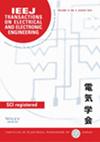下载PDF
{"title":"Data-Driven Temperature Deviation Estimation of a Proton Exchange Membrane Water Electrolyzer Stack from Electrochemical Impedance Using Machine Learning","authors":"Noboru Katayama, Ryoma Iki, Xing-Xing Chen, Ka-Hong Loo","doi":"10.1002/tee.70009","DOIUrl":null,"url":null,"abstract":"<p>We developed a method to analyze temperature variations in proton exchange membrane water electrolysis stacks by using machine learning to interpret electrochemical impedance spectroscopy (EIS) data. To train the machine learning model, we artificially generated impedance data at various temperature differences by merging data from uniformly heated stacks. The impedance data were collected using a dual active bridge DC/DC converter to apply a range of DC currents and an AC current through phase shift fluctuations. These data were then sampled for impedance analysis. A deep neural network was employed to correlate the real and imaginary components of impedance across frequencies with the stack's average temperatures and temperature variances. Our model, evaluated with actual thermal condition data, successfully predicted average temperatures and temperature differences within 2°C and 5°C accuracy, respectively, showing its potential for monitoring and managing temperature and other parameters in electrolysis stacks only by EIS and a deep neural network. © 2025 The Author(s). <i>IEEJ Transactions on Electrical and Electronic Engineering</i> published by Institute of Electrical Engineers of Japan and Wiley Periodicals LLC.</p>","PeriodicalId":13435,"journal":{"name":"IEEJ Transactions on Electrical and Electronic Engineering","volume":"20 9","pages":"1488-1496"},"PeriodicalIF":1.1000,"publicationDate":"2025-03-08","publicationTypes":"Journal Article","fieldsOfStudy":null,"isOpenAccess":false,"openAccessPdf":"https://onlinelibrary.wiley.com/doi/epdf/10.1002/tee.70009","citationCount":"0","resultStr":null,"platform":"Semanticscholar","paperid":null,"PeriodicalName":"IEEJ Transactions on Electrical and Electronic Engineering","FirstCategoryId":"5","ListUrlMain":"https://onlinelibrary.wiley.com/doi/10.1002/tee.70009","RegionNum":4,"RegionCategory":"工程技术","ArticlePicture":[],"TitleCN":null,"AbstractTextCN":null,"PMCID":null,"EPubDate":"","PubModel":"","JCR":"Q4","JCRName":"ENGINEERING, ELECTRICAL & ELECTRONIC","Score":null,"Total":0}
引用次数: 0
引用
批量引用
Abstract
We developed a method to analyze temperature variations in proton exchange membrane water electrolysis stacks by using machine learning to interpret electrochemical impedance spectroscopy (EIS) data. To train the machine learning model, we artificially generated impedance data at various temperature differences by merging data from uniformly heated stacks. The impedance data were collected using a dual active bridge DC/DC converter to apply a range of DC currents and an AC current through phase shift fluctuations. These data were then sampled for impedance analysis. A deep neural network was employed to correlate the real and imaginary components of impedance across frequencies with the stack's average temperatures and temperature variances. Our model, evaluated with actual thermal condition data, successfully predicted average temperatures and temperature differences within 2°C and 5°C accuracy, respectively, showing its potential for monitoring and managing temperature and other parameters in electrolysis stacks only by EIS and a deep neural network. © 2025 The Author(s). IEEJ Transactions on Electrical and Electronic Engineering published by Institute of Electrical Engineers of Japan and Wiley Periodicals LLC.
基于电化学阻抗的质子交换膜水电解槽堆数据驱动温度偏差估计
我们开发了一种通过机器学习来解释电化学阻抗谱(EIS)数据来分析质子交换膜电解堆温度变化的方法。为了训练机器学习模型,我们通过合并来自均匀加热堆栈的数据,人为地生成了不同温差下的阻抗数据。阻抗数据通过双有源桥式DC/DC变换器收集,通过相移波动施加一定范围的直流电流和交流电流。然后对这些数据进行采样以进行阻抗分析。采用深度神经网络将阻抗的实、虚分量与堆栈的平均温度和温度方差相关联。我们的模型,用实际的热条件数据进行评估,成功地预测了平均温度和温差,分别在2°C和5°C的精度范围内,显示了其仅通过EIS和深度神经网络监测和管理电解堆温度和其他参数的潜力。©2025作者。电气与电子工程学报,日本电气工程师学会和Wiley期刊公司出版。
本文章由计算机程序翻译,如有差异,请以英文原文为准。


 求助内容:
求助内容: 应助结果提醒方式:
应助结果提醒方式:


